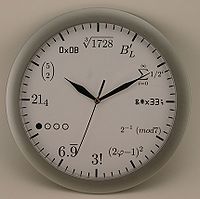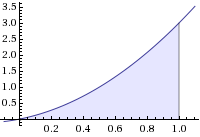Course:MATH103/Archive/2010-2011/207/Lectures/Lecture07
| Faculty of Science Department of Mathematics | |
|---|---|

| |
| Course Pages | |
| Course Policies | |
| Math Solvers | |
| Exams | |
| Quizzes | |
| Assignments | |
| Lectures | |
Lecture 7
Readings For This Lecture
- Chapter 4, pages 61 to 71 (up to subsection 4.4)
Summary
Group 1: Add a summary of the lecture in this space. Include examples, discussion, and links to external sources, if desired.
Exercises
1. The speed of a car (km/h) is given by the expression
,
where is the time in hours. Use this expression to find the acceleration of the vehicle over the time period, and the total displacement.
| Solution |
|---|
| Total Displacement over time period
If I'm not mistaken, shouldn't you take the integral of the derivative of acceleration to get the change in acceleration over a time period. You took the integral of the acceleration which would be the velocity over the integral.
|
2.The velocity of a boat moving through the water is found to be
.
Find the acceleration of the boat and show that it satisfies a differential equation of the form
.
is a constant (find its value). Find the displacement of the boat at time .
3. A particle in a force field accelerates according to the expression
.
Find the velocity of the particle, assuming it starts at rest at . Then find the total displacement of the particle of the time period.
4. The reaction time of a driver (time it takes to notice and react to danger in the road ahead) is about 0.5 seconds. When the brakes are applied, it then takes the car some time to decelerate and come to a full stop. If the deceleration rate is , how long would it take the driver to stop from an initial speed of 100 km/h? (Include both reaction time and deceleration time, and use the Fundamental Theorem of Calculus to arrive at your answer.)
5. The density of a band of protein along a one-dimensional strip of gel in an electrophoresis experiment is given by ,
where x is the distance along the strip in centimetres and is the protein density (i.e. protein mass per cm) at distance . Find the total mass of the protein in the band .
6. The air density h meters above the earth’s surface is
.
Find the mass of a cylindrical column of air of radius meters and height meters. Let , per meter. In order to set up the integral, consider how to approach this as a Riemann Sum.
7. A test-tube contains a solution of glucose which has been prepared so that the concentration of glucose is greatest at the bottom and decreases gradually towards the top of the fluid. (This is called a density gradient). Suppose that the concentration as a function of the depth is . The radius of the tube is 2 cm and the height of the glucose-containing solution is 10 cm. Determine the total amount of glucose in the tube (in gm).
8. Oil leaks out of an oil tanker at the rate (where is in 10 thousand barrels per hour and is in hours). (Note: This function only makes sense as long as since a negative flow of oil is meaningless in this case.) At what time will the flow be zero? What is the total amount that has leaked out between and the time you've found?


























